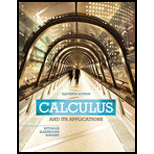
Concept explainers
Sally makes deposits into a retirement account every year from the age of 30 until she retires at age 65.
a. Sally plans to take regular monthly distributions from her retirement account from the time she retires until she is 80 years old, when the account will have a value of $0. How much should she take each month? Assume the interest rate is 4% per year, compounded monthly. (Hint: Use the formula given for Exercises 33 and 34 that calculates the monthly payments on a loan.)
b. What is the total of the payments she will receive? How much of the total will be her own money (see part b of Exercise 39), and how much will be interest?
Want to see the full answer?
Check out a sample textbook solution
Chapter R Solutions
Calculus and Its Applications (11th Edition)
Additional Math Textbook Solutions
Elementary Statistics
Basic Business Statistics, Student Value Edition
Calculus for Business, Economics, Life Sciences, and Social Sciences (14th Edition)
Pre-Algebra Student Edition
- Graph y=log2(x+3) 10+ 9 8 7- 6 5 4 3 3 2 1 10 -9 -8 -7 -6 -5 -4 -3-2-1 1 2 3 4 5 6 7 8 7 8 9 10 -1 -2 -3 -4 -5 -6 -7- -8 -9 -10 Clear All Drawarrow_forwardWrite an equation for the graph below. +10+ 9 10 -9 -8 -7 -6 -5 -4 -3-2-1 8 7 6 5 4 3 2 1 1 3 4 5 6 7 8 9 10 -1 -2 -3 -4 -5 -6 -7 -8 f(x) = 9 -9 -10-arrow_forward3. Solve the inequality and give your answer in interval notation. Be sure to show all your work, and write neatly so your work is easy to follow. (4 points) 2|3x+12 ≥ 18arrow_forward
- - 2. In words, interpret the inequality |x8|> 7 the same way I did in the videos. Note: the words "absolute value" should not appear in your answer! (2 points)arrow_forwardFind the tangential and normal components of the acceleration vector for the curve (t) = (2t, -3t5,-3+4) at the point t = 1 ā(1) = T + N Give your answers to two decimal placesarrow_forwardA gun is fired with muzzle velocity 1152 feet per second at a target 4150 feet away. Find the minimum angle of elevation necessary to hit the target. Assume the initial height of the bullet is 0 feet, neglect air resistance, and give your answer in degrees.arrow_forward
- "Use the Opposite Method to solve the following differential equation:" 4'"""" + 34" + 34 + 4 = xarrow_forwardFor the curve defined by (t) = (e cos(t), et sin(t)) find the unit tangent vector, unit normal vector, normal acceleration, and tangential acceleration at πT t = 3 П I(3) 丌_3_3 N (1) ат aN || = = =arrow_forwardFind the velocity vector for the position vector (t) = (sin(9+), 9t10, e¯7). x component = y component = Z component =arrow_forward
- In the xy-plane, an angle 0, in standard position, has a measure of the following is true? T. Which of 3 A The slope of the terminal ray of the angle is 1. B The slope of the terminal ray of the angle is 1. C D 3 The slope of the terminal ray of the angle is ✓ 2 The slope of the terminal ray of the angle is √3.arrow_forwardy'''-3y''+4y=e^2x Find particular solutionarrow_forward1 -1- Ο Graph of f y = + y = 1 + 1/2 ·2· x Graph of g y = 1- 플 The figure gives the graphs of the functions f and g in the xy-plane. The function of is given by f(x) = tan¹ x. Which of the following defines g(x)? A tan 1 x + 1 B - tan 1 x + П 2 C tan-1 (2/2) + 1 D tan-1 (2/2) + 1/1arrow_forward

 Algebra and Trigonometry (MindTap Course List)AlgebraISBN:9781305071742Author:James Stewart, Lothar Redlin, Saleem WatsonPublisher:Cengage Learning
Algebra and Trigonometry (MindTap Course List)AlgebraISBN:9781305071742Author:James Stewart, Lothar Redlin, Saleem WatsonPublisher:Cengage Learning College AlgebraAlgebraISBN:9781305115545Author:James Stewart, Lothar Redlin, Saleem WatsonPublisher:Cengage Learning
College AlgebraAlgebraISBN:9781305115545Author:James Stewart, Lothar Redlin, Saleem WatsonPublisher:Cengage Learning Algebra & Trigonometry with Analytic GeometryAlgebraISBN:9781133382119Author:SwokowskiPublisher:Cengage
Algebra & Trigonometry with Analytic GeometryAlgebraISBN:9781133382119Author:SwokowskiPublisher:Cengage





